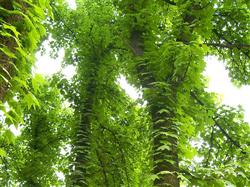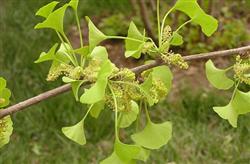Conservation measures of Ginkgo biloba trees in summer

First, the life of Ginkgo biloba is long, but improper planting management, especially the loss of topsoil, will make a large number of roots exposed on the surface, especially the ginkgo biloba growing on the slope. when serious, the depth of root exposure can reach more than 30 cm. Therefore, we should do a good job of soil cultivation, so that the root system is buried under the soil surface, in order to give full play to its role of absorbing nutrients and water. Second, the root system of ginkgo biloba is well developed. in summer, the soil around the main absorbing root should be kept loose. in general, the part under the crown of ginkgo biloba should be kept loose for a long time (ploughing at least twice a year in a ginkgo garden). Third, fertilizer can be applied to cake fertilizer in areas with suitable conditions, because ginkgo biloba has strong adaptability to cake fertilizer, and topdressing in the early stage of fruit expansion can make the fruit grow rapidly without falling off. After the beginning of summer, nitrogen fertilizer should be applied cautiously, depending on plant growth, generally with 0.3% to 0.5% urea solution foliar spraying or 1% to 2% urea solution sprinkled on the ground. Fourth, drainage and irrigation ginkgo likes to be wet, but it is afraid of stagnant water. The experiment shows that ginkgo biloba growing on river embankment and sandy soil will not cause fatal harm when soaked in running water for less than 7 days, but the root system of ginkgo biloba will die if it is immersed in water for more than 10 days. Therefore, after the rainstorm, especially in the rainy weather, or when the soil is heavy, the drainage is poor, and the groundwater level is high, special attention should be paid to ditching and drainage. Ginkgo biloba is not resistant to stagnant water and excessive drought, and low air humidity will also affect the growth and fruiting of ginkgo biloba, especially in the period of rapid seed expansion and flower bud differentiation. The long-term drought will not only greatly reduce the seed size of the current year, but also affect the yield of the second year. Therefore, the weather is continuously dry, especially in the high temperature and drought season with large water demand, the ginkgo garden should be irrigated at the right time.
- Prev

High-yield cultivation techniques of Ginkgo biloba for leaves
1. Site selection of leaf ginkgo orchard requires flat terrain, good drainage and irrigation conditions, fertile loam or sandy loam, and it is not suitable to build leaf ginkgo orchard in saline-alkali land and mountain thin land. two。 Planting technology Ginkgo biloba orchard can be directly sowed or planted with seedlings or cuttings. The planting time is spring and autumn.
- Next

How to make ginkgo early blossom and early fruit
First, drawing branches starts from the young tree stage of Ginkgo biloba, and the plants with small branching angles open through drawing branches to ease the growth of trees and branches and promote flower formation. The convenient bag containing soil can be tied to the tip of the upright branch at the beginning of May. The weight of the soil bag is determined according to the growth of the branch and the requirement of pulling the branch.
Related
- Fuxing push coffee new agricultural production and marketing class: lack of small-scale processing plants
- Jujube rice field leisure farm deep ploughing Yilan for five years to create a space for organic food and play
- Nongyu Farm-A trial of organic papaya for brave women with advanced technology
- Four points for attention in the prevention and control of diseases and insect pests of edible fungi
- How to add nutrient solution to Edible Fungi
- Is there any good way to control edible fungus mites?
- Open Inoculation Technology of Edible Fungi
- Is there any clever way to use fertilizer for edible fungus in winter?
- What agents are used to kill the pathogens of edible fungi in the mushroom shed?
- Rapid drying of Edible Fungi

